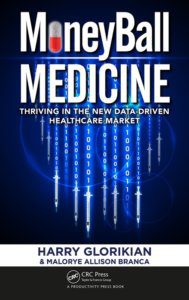The Future You:
How Artificial Intelligence Can Help You Get Healthier, Stress Less, and Live Longer
Need to lose a few pounds but struggle to maintain a healthy diet? Toss and turn at night with insomnia? Want a new exercise routine that will give you maximum results? Wonder about your risk of developing cancer or diabetes? Want to understand how to work with your doctor to tailor your care based on your own genetic makeup? Do you want to learn how you can shape the best and healthiest version of yourself and how artificial intelligence (AI) can be a powerful tool on that journey?
The Future You explores how AI is disrupting healthcare and what you need to know to navigate the new medical paradigm and improve your health in monumental ways—starting today.
You’ll learn how doctors are treating once-incurable diseases by rewriting our DNA, and how AI is helping them diagnose different cancers more precisely.
You’ll see how people like you have used smartphone and smartwatch technology to reach your health and fitness goals, and sometimes to survive a health emergency.
You’ll understand how scientists around the world used AI to develop COVIDvaccines at record speed and repurpose existing drugs to fight the virus—and how AI will help us identify future outbreaks more rapidly.
There’s quite literally nothing about health and wellness that won’t be utterly transformed by the power of AI. The Future You will show you what’s coming—and what is already here.
Also available from:
What People Say
“The Future You is a concise and relatable synthesis of the bleeding edge of biomedical research. If you feel excitement and wonder from reading the latest news headlines of sci-fi-like breakthroughs in artificial intelligences and biomedicine, yet find yourself wondering, ‘What does this mean for me?’, then you will find no better guide than The Future You. In the spirit of the enduring William Gibson quote, ‘The future is here—it’s just not evenly distributed,’ The Future Youastonishes readers with stories from the frontlines of biomedical innovation happening today while providing relatable and actionable information on how you can take action in your own daily life to anticipate and participate in the coming biomedical revolution.”
Joel Dudley
PhD, Chief Scientific Officer, Tempus Labs, Inc.
“AI and technology are disrupting healthcare at an unprecedented rate, reshaping how we treat and address disease. Author Harry Glorikian is able to distill complex biomedical science from the experts into thoughtful explanations and insights on how readers can benefit from these advancements in their own health and wellness journeys. The Future You examines what is possible from leading healthcare researchers and practitioners as they work to discover better ways to treat patients and improve lives.”
Andrew Radin
CEO, Aria Pharmaceuticals
“The Future You provides a glimpse into the fascinating and unique dimensions of medical and biomedical research in healthcare. As with Stephen Hawkings and his predicted breakthroughs in astrophysics, AI will continue to reveal deeper insights into the way the body works and the new strategies we need to adopt to lead healthy lives. Since becoming a doctor in biomedical sciences and a clinician, I’ve discovered that there is more that we don’t know than answers to what we do know. Every human and other living thing on this beautiful planet shares this trait. As a patient with a rare disease who battles multiple sclerosis-like and Parkinson’s-like symptoms, my life so far confirms my observation that we need to understand the making of us.
In light of the advances in genomics, artificial intelligence, and microbiome research discussed in The Future You, I am more optimistic that the future will bring a lot of hope to patients such as myself. With a focus on that future, this book will serve as an invaluable primer for patients, physicians, healthcare innovators, investors, and the general public. A deep insight into healthcare innovation provided in The Future You is the ultimate blessing any reader will reach based on Hippocrates’ declaration: “Health is the greatest blessing in life.”
It is time to know you as a supreme being, so that you can become the most incredible version of yourself possible.”
Dr. Kamala Maddali
President, Health Collaborations, a Rare Disease Patient and Healthcare Changemaker
“In the future we’ll see a shift from short-term sick care to prioritizing preventive long-term healthcare. Integrating AI, data, and technology into the industry is the only way to get there. Harry Glorikian’s analysis of the smart medicine movement in The Future You is the blueprint to how we can live better, healthier lives.“
Harpreet Singh Rai
CEO, Oura
“It’s inevitable that the practice of medicine is on the verge of a quantified and intelligent revolution. Just as in other industries before it, healthcare and medicine will be more personalized and hopefully proactive. In some cases, medical care will be a completely digital experience. The Future You brings this vision to life and details the tangible progress being made in traditional medicines, medical devices, healthcare companies, inventive startups, and technology giants. It’s a must-read not just for fans of the “digital health” industry, but for all individuals interested in a future where medicine is made and delivered uniquely “for me and powered uniquely by me and my data.“
Christine Lemke
Co-CEO and Co-founder, Evidation
“The Future You is a wonderful read on how AI is quickly transforming our notions of health and wellness. The book encourages everyone to be proactive and embrace the upcoming monumental changes, to benefit earlier rather than later from the new powerful technologies unleashed by AI. It is a fun read, superbly blending personal anecdotes and rigorous studies, leveraging Mr. Glorikian’s lifetime experience in tech, biotech, AI and investing. All aspects of personal wellness and health are thoughtfully covered, from food and exercise, to monitoring heart and mental health. The Chapter on the Covid19 pandemic is the best exposition of the subject that I have ever seen. This book gives the reader insightful information about the ongoing AI revolution that is profoundly affecting our lives, while also giving a heads up about even bigger changes that are on the horizon.”
Garyk Papoian
“With “The Future of You,” Harry Glorikian brings his deep knowledge of the digitalization of healthcare in general and artificial intelligence in particular to the next great frontier: consumer directed, managed and empowered health. (Extremely) smart watches, wearables and other noninvasive data collection devices, combined with readily available and inexpensive access to enormous computing power, memory and storage, provide consumers with insights into their health and its management that even the most technologically intensive healthcare systems could not provide just a few years ago. But these capabilities pale in comparison to what is coming from the combined efforts of individuals tinkering in their garages and basements and professional teams in the largest tech companies in the world.
“The Future of You” is both a great overview and a guided tour of these new capabilities, their power, their limitations and the challenges for the future. Properly understood and used, AI puts tremendous power in our hands to proactively manage our health, and, when needed, to be better partners with our doctors and their staffs as we discover what makes each of us — as individuals– tick, and how we can choose a more customized path to get and stay healthy. Highly recommended.”
David Sable
“If you care about your health—and who doesn’t?—this book is a primer on how you can take advantage of current technology in the healthcare field. Harry Glorikian shares his impressive expertise in highly engaging layperson’s language; read how artificial intelligence and big data are rapidly advancing the world of medicine in ways that enable us to monitor and address our personal health journey more closely and more accurately than ever before. The Future You is one of the finest and most significant projects I have had the pleasure of being associated with in my decades as an editor. It’s a must-have, must-read—and a must-re-read!”





